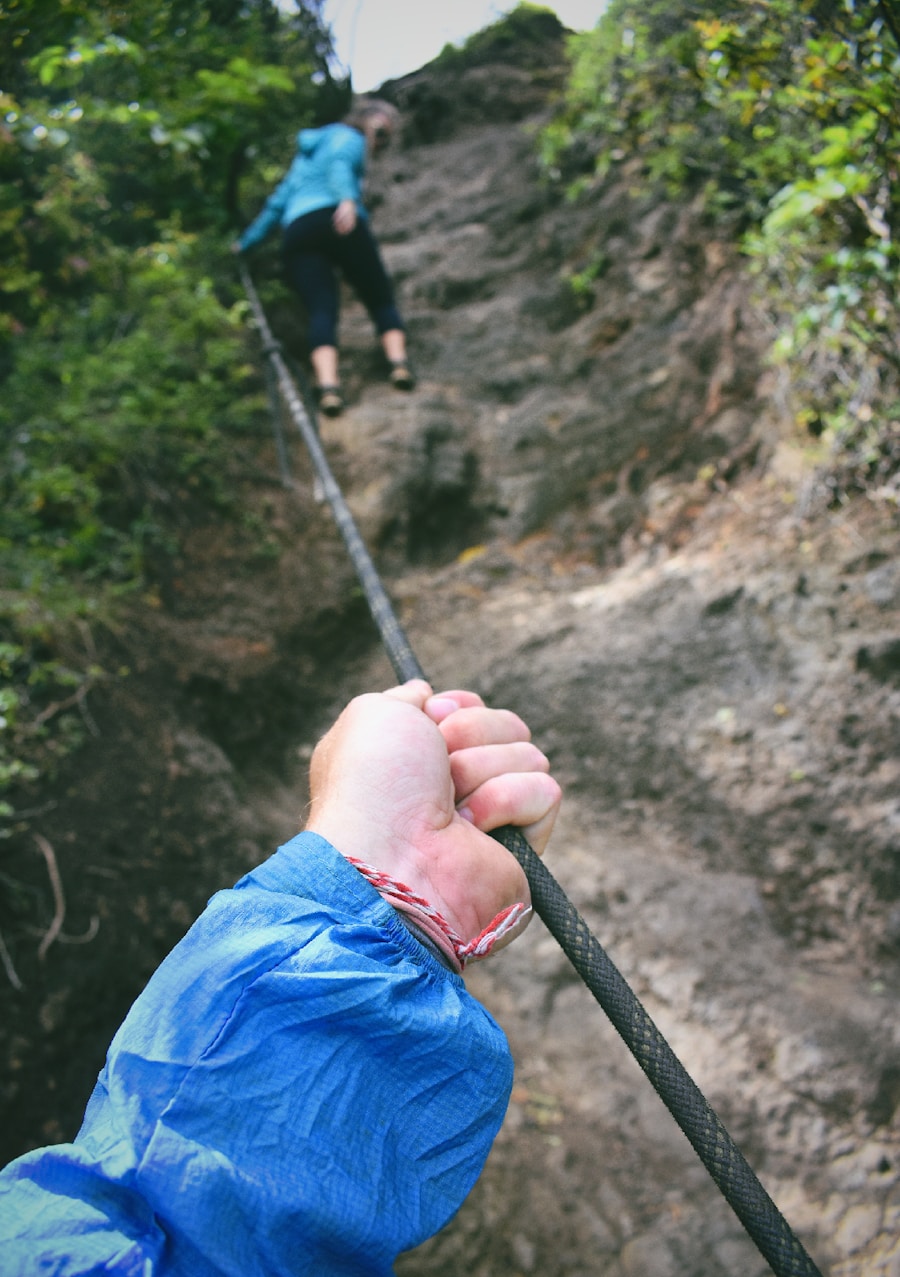Hiking sticks, often referred to as trekking poles, have become an essential piece of equipment for outdoor enthusiasts. These versatile tools are designed to enhance the hiking experience by providing stability, support, and balance on various terrains. Historically, hiking sticks have been used for centuries, with evidence of their use dating back to ancient civilizations.
They were initially crafted from natural materials like wood, but modern advancements have led to the development of lightweight and durable materials such as aluminum and carbon fiber. This evolution has made hiking sticks more accessible and appealing to a broader range of hikers, from casual walkers to seasoned adventurers. The appeal of hiking sticks lies not only in their functional benefits but also in the sense of security they provide.
For many hikers, the act of using a stick can instill confidence when navigating challenging trails or uneven surfaces. The rhythmic motion of planting the stick can also create a meditative quality to the hike, allowing individuals to connect more deeply with their surroundings. As outdoor activities continue to gain popularity, understanding the nuances of hiking sticks becomes increasingly important for both novice and experienced hikers alike.
Key Takeaways
- Hiking sticks are essential tools for hikers, providing stability and support on various terrains.
- When choosing hiking sticks, consider factors such as material, weight, grip, and adjustability to find the right fit for your needs.
- Proper technique for using hiking sticks involves using them in sync with your natural walking rhythm and distributing weight evenly.
- Using hiking sticks can reduce strain on the knees, improve balance, and provide additional support on challenging terrain.
- Regularly adjust and maintain your hiking sticks to ensure they remain in good condition and provide optimal support during hikes.
Choosing the Right Hiking Sticks for You
Selecting the appropriate hiking sticks involves considering several factors that cater to individual needs and preferences. One of the primary considerations is the material of the poles. Aluminum poles are known for their durability and affordability, making them a popular choice for beginners or those on a budget.
On the other hand, carbon fiber poles are lighter and absorb shock better, which can be advantageous for long-distance hikers or those tackling rugged terrain. The choice between these materials often comes down to personal preference and the specific demands of the hiking environment. Another critical aspect to consider is the adjustability of the hiking sticks.
Many models feature telescoping designs that allow users to modify the length of the poles according to their height and the type of terrain they are traversing. A general rule of thumb is that when standing upright with the pole, your elbow should form a 90-degree angle. Additionally, some hiking sticks come equipped with features such as ergonomic grips, wrist straps, and interchangeable tips for different surfaces, which can enhance comfort and functionality.
Evaluating these features in relation to your hiking style will help ensure that you choose sticks that will serve you well on your adventures.
Proper Technique for Using Hiking Sticks

Mastering the proper technique for using hiking sticks can significantly enhance your hiking experience. The fundamental principle is to maintain a natural rhythm while walking. As you step forward with one foot, the opposite stick should be planted in front of you, ideally at a slight angle to provide maximum support.
This technique not only helps distribute your weight more evenly but also engages your upper body muscles, providing an additional workout during your hike. When using hiking sticks, it is essential to maintain a relaxed grip on the handles. A tight grip can lead to fatigue in your hands and arms over time.
Instead, allow your hands to rest comfortably on the grips while utilizing the wrist straps for added security. This technique allows you to transfer some of your weight onto the poles without straining your hands. Additionally, be mindful of your posture; keeping your back straight and shoulders relaxed will help prevent unnecessary strain on your body as you navigate various terrains.
Benefits of Using Hiking Sticks
| Benefits of Using Hiking Sticks |
|---|
| 1. Improved Stability |
| 2. Reduced Impact on Joints |
| 3. Increased Endurance |
| 4. Enhanced Balance |
| 5. Better Posture |
| 6. Enhanced Upper Body Workout |
The benefits of using hiking sticks extend beyond mere convenience; they can significantly impact your overall hiking experience. One of the most notable advantages is improved stability and balance. When traversing rocky paths or steep inclines, having an extra point of contact with the ground can help prevent slips and falls.
This added stability is particularly beneficial for older hikers or those with joint issues, as it reduces the risk of injury while providing additional support. Moreover, hiking sticks can alleviate stress on your joints, particularly in the knees and ankles. By distributing weight more evenly across your body, they help reduce the impact on these critical areas during descents or when navigating uneven terrain.
Studies have shown that using trekking poles can decrease knee joint load by up to 25%, making them an invaluable tool for those who may be prone to joint pain or discomfort during long hikes. Additionally, they can enhance endurance by engaging upper body muscles, allowing hikers to maintain their energy levels over extended periods.
Adjusting and Maintaining Your Hiking Sticks
Proper adjustment and maintenance of hiking sticks are crucial for ensuring their longevity and effectiveness. Most trekking poles feature a locking mechanism that allows users to easily adjust their height. It is advisable to check these mechanisms regularly for any signs of wear or damage, as a malfunctioning lock can lead to unexpected collapses during use.
When adjusting the height, ensure that both poles are set to the same length for optimal balance and stability. Maintenance also involves cleaning your hiking sticks after each use, especially if you’ve been trekking through muddy or wet conditions. Dirt and debris can accumulate in the locking mechanisms and joints, potentially leading to corrosion or malfunction over time.
A simple wipe-down with a damp cloth followed by thorough drying can help preserve their functionality. Additionally, inspecting the tips for wear and replacing them as needed will ensure that your poles maintain traction on various surfaces.
Using Hiking Sticks for Uphill and Downhill Hiking

The technique for using hiking sticks varies significantly between uphill and downhill hiking due to the differing demands placed on your body during these activities. When ascending a hill, it is beneficial to plant your poles ahead of you at an angle that allows you to push off with your arms as you step up with your legs. This technique not only provides additional propulsion but also helps conserve energy by engaging your upper body muscles effectively.
Conversely, when descending, the focus shifts to using the poles as a stabilizing force. Planting them firmly in front of you can help control your descent and reduce the impact on your knees. It is advisable to keep your elbows slightly bent while using the poles downhill; this position allows for better shock absorption and control as you navigate steep declines.
By mastering these techniques for both uphill and downhill hiking, you can enhance your overall efficiency and enjoyment on the trail.
Safety Tips for Using Hiking Sticks
While hiking sticks offer numerous benefits, it is essential to use them safely to maximize their advantages while minimizing risks. One critical safety tip is to be aware of your surroundings at all times. When using trekking poles in crowded areas or on narrow trails, ensure that you do not inadvertently poke or trip other hikers with your poles.
Maintaining a safe distance from others while navigating tricky sections will help prevent accidents. Additionally, be cautious when crossing streams or navigating slippery surfaces. While hiking sticks provide stability, they should not be relied upon solely for balance in precarious situations.
Instead, use them as an aid while remaining vigilant about where you place your feet. Practicing good judgment in challenging conditions will enhance your safety on the trail and allow you to enjoy your hike without unnecessary worry.
Alternative Uses for Hiking Sticks
Beyond their primary function as support during hikes, trekking poles can serve various alternative purposes that enhance outdoor experiences. For instance, they can be utilized as makeshift tent poles when camping in areas without established sites or when improvisation is necessary due to unexpected circumstances. Their lightweight nature makes them easy to carry along on multi-day treks where versatility is key.
Moreover, hiking sticks can also be employed in emergency situations as self-defense tools against wildlife encounters or aggressive individuals in remote areas. While this should always be a last resort, having a sturdy pole at hand can provide an added layer of security during solo hikes or in unfamiliar territories. Additionally, they can serve as a tool for measuring depth when crossing streams or rivers, allowing hikers to gauge safe passage without risking their safety.
In conclusion, hiking sticks are invaluable companions for outdoor enthusiasts seeking stability and support on their adventures. By understanding how to choose the right pair, employing proper techniques, and recognizing their multifaceted benefits, hikers can significantly enhance their experiences in nature while ensuring safety and enjoyment along the way.
If you are looking to enhance your hiking experience, consider investing in a pair of compact binoculars to help you spot wildlife and take in the beautiful scenery. Additionally, having a reliable travel fishing rod can add an extra element of adventure to your outdoor excursions. And don’t forget to wear a pair of odor-resistant merino wool travel socks to keep your feet comfortable and dry during long hikes.
FAQs
What are hiking sticks?
Hiking sticks, also known as trekking poles, are lightweight, adjustable poles used by hikers to provide stability and support while walking on uneven terrain.
How do you use hiking sticks?
To use hiking sticks, adjust the length to a comfortable height, grip the handle firmly, and plant the tip of the stick on the ground as you walk. Use the sticks to help support your weight and provide stability on rough or steep terrain.
What are the benefits of using hiking sticks?
Hiking sticks can help reduce strain on the knees and joints, improve balance and stability, and provide additional support when carrying a heavy backpack. They can also help to increase speed and efficiency while hiking.
How do you choose the right hiking sticks?
When choosing hiking sticks, consider factors such as weight, material, grip comfort, and adjustability. It’s important to select sticks that are the right length for your height and have features that suit your hiking style and terrain.
Are there any tips for using hiking sticks?
When using hiking sticks, it’s important to maintain a natural arm swing and rhythm, and to adjust the length of the sticks for uphill and downhill sections. It’s also helpful to use wrist straps to prevent dropping the sticks and to distribute weight more evenly.
